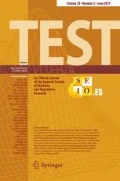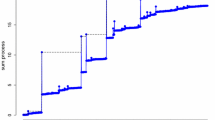Abstract
For stationary sequences, under general dependence restrictions, any limiting point process for time normalized upcrossings of high levels is a compound Poisson process, i.e., there is a clustering of high upcrossings, where the underlying Poisson points represent cluster positions and the multiplicities correspond to cluster sizes. For such classes of stationary sequences, there exists the upcrossings index η, 0≤η≤1, which is directly related to the extremal index θ, 0≤θ≤1, for suitable high levels. In this paper, we consider the problem of estimating the upcrossings index η for a class of stationary sequences satisfying a mild oscillation restriction. For the proposed estimator, properties such as consistency and asymptotic normality are studied. Finally, the performance of the estimator is assessed through simulation studies for autoregressive processes and case studies in the fields of environment and finance. Comparisons with other estimators derived from well known estimators of the extremal index are also presented.














Similar content being viewed by others
References
Carlstein E (1986) The use of subseries values for estimating the variance of a general statistic from a stationary sequence. Ann Stat 14:1171–1179
Chernick M, Hsing T, McCormick W (1991) Calculating the extremal index for a class of stationary sequences. Adv Appl Probab 23:835–850
Drees H (2011) Bias correction for estimators of the extremal index. arXiv:1107.0935v1
Ferreira H (2006) The upcrossing index and the extremal index. J Appl Probab 43:927–937
Ferreira H (2007) Runs of high values and the upcrossings index for a stationary sequence. In: Proceedings of the 56th session of the ISI
Ferreira M, Ferreira H (2012) On extremal dependence: some contributions. Test 21(3):566–583
Ferro CAT, Segers J (2002) Automatic declustering of extreme values via an estimator for the extremal index. Technical Report 2002-025. EURANDOM Eindhoven http://alexandria.tue.nl/repository/books/557750.pdf
Ferro CAT, Segers J (2003) Inference for clusters of extreme values. J R Stat Soc B 65:545–556
Gomes MI, Oliveira O (2001) The bootstrap methodology in statistics of extremes—choice of the optimal sample fraction. Extremes 4(4):331–358
Gomes MI, Hall A, Miranda C (2008) Subsampling techniques and the jackknife methodology in the estimation of the extremal index. J Stat Comput Simul 52:2022–2041
Hsing T (1991) Estimating the parameters of rare events. Stoch Process Appl 37:117–139
Hsing T (1993) Extremal index estimation for a weakly dependent stationary sequence. Ann Stat 21:2043–2071
Hsing T, Hüsler J, Leadbetter MR (1988) On the exceedance point process for a stationary sequence. Probab Theory Relat Fields 78:97–112
Klar B, Lindner F, Meintanis SG (2011) Specification tests for the error distribution in Garch models. Comput Stat Data Anal. doi:10.1016/j.csda.2010.05.029
Künsch H (1989) The jackknife and the bootstrap for general stationary observations. Ann Math 17(3):1217–1241
Lahiri SN (2003) Resampling methods for dependent data. Springer, Berlin
Laurini F, Tawn J (2006) The extremal index for GARCH(1, 1) processes with t-distributed innovations. http://www.scientificcommons.org/17368349
Leadbetter MR (1983) Extremes and local dependence in stationary processes. Z Wahrscheinlichkeitstheor Verw Geb 65:291–306
Leadbetter MR, Nandagopalan S (1988) On exceedance point process for stationary sequences under mild oscillation restrictions. In: Hüsler J, Reiss D (eds) Extreme value theory: proceedings, Oberwolfach 1987. Springer, New York, pp 69–80
Liu RY, Singh K (1992) Moving blocks jackknife and bootstrap capture weak dependence. In: Lepage R, Billard L (eds) Exploring the limits of bootstrap. Wiley, New York, pp 225–248
Mikosch T, Stărică C (2000) Limit theory for the sample autocorrelations and extremes of a GARCH(1, 1) process. Ann Stat 28:1427–1451
Nandagopalan S (1990) Multivariate extremes and estimation of the extremal index. Ph.D. Thesis, University of North Carolina, Chapel Hill
Politis DN, Romano JP (1992) A circular block resampling procedure for stationary data. In: Lepage R, Billard L (eds) Exploring the limits of bootstrap. Wiley, New York, pp 263–270
Politis DN, Romano JP (1994) The stationary bootstrap. J Am Stat Assoc 89:1303–1313
Reiss R-D, Thomas M (2007) Statistical analysis of extreme values with applications to insurance, finance, hydrology and other fields. Birkhäuser, Basel
Robert CY (2009) Inference for the limiting cluster size distribution of extreme values. Ann Stat 37:271–310
Robert CY, Segers J, Ferro C (2009) A sliding blocks estimator for the extremal index. Electron J Stat 3:993–1020
Sebastião J, Martins AP, Pereira L, Ferreira H (2010) Clustering of upcrossings of high values. J Stat Plan Inference 140:1003–1012
Singh K (1981) On the asymptotic accuracy of the Efron’s bootstrap. Ann Stat 9:345–362
Süveges M (2007) Likelihood estimation of the extremal index. Extremes 10:41–55
Süveges M, Davison A (2010) Model misspecification in peaks over threshold analysis. Ann Appl Stat 4:203–221
Weissman I, Novak SY (1998) On blocks and runs estimators of the extremal index. J Stat Plan Inference 66(2):281–288
Acknowledgements
We are grateful to the anonymous referees for their valuable criticisms, corrections and suggestions which helped considerably the final form of this paper.
We acknowledge the support from research unit “Centro de Matemática” of the University of Beira Interior, the research project PTDC/MAT/108575/2008 through the Foundation for Science and Technology (FCT) co-financed by FEDER/COMPETE and SFRH/BD/41439/2007.
Author information
Authors and Affiliations
Corresponding author
Rights and permissions
About this article
Cite this article
Sebastião, J.R., Martins, A.P., Ferreira, H. et al. Estimating the upcrossings index. TEST 22, 549–579 (2013). https://doi.org/10.1007/s11749-013-0315-9
Received:
Accepted:
Published:
Issue Date:
DOI: https://doi.org/10.1007/s11749-013-0315-9



